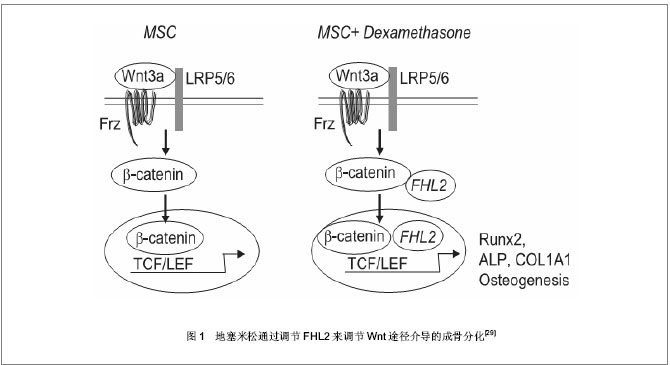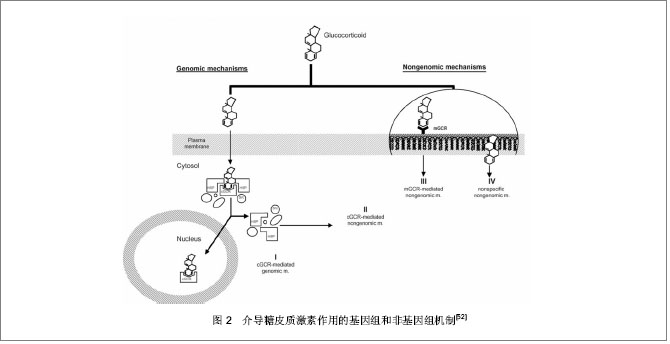| [1] Blackwell GJ, Carnuccio R, Di Rosa M,et al. Macrocortin: a polypeptide causing the anti-phospholipase effect of glucocorticoids.Nature. 1980;287(5778):147-149.[2] Sapolsky RM, Pulsinelli WA.Glucocorticoids potentiate ischemic injury to neurons: therapeutic implications.Science. 1985;229(4720):1397-1400.[3] Scheinman RI, Cogswell PC, Lofquist AK,et al. Role of transcriptional activation of I kappa B alpha in mediation of immunosuppression by glucocorticoids.Science. 1995;270 (5234): 283-286.[4] Bamberger CM, Schulte HM, Chrousos GP. Molecular determinants of glucocorticoid receptor function and tissue sensitivity to glucocorticoids. Endocr Rev. 1996;17(3): 245-261.[5] Sapolsky RM, Romero LM, Munck AU. How do glucocorticoids influence stress responses? Integrating permissive, suppressive, stimulatory, and preparative actions. Endocr Rev. 2000;21(1):55-89.[6] Munck A, Guyre PM, Holbrook NJ.Physiological functions of glucocorticoids in stress and their relation to pharmacological actions.Endocr Rev. 1984;5(1):25-44.[7] Caplan AI.Mesenchymal stem cells.J Orthop Res. 1991;9(5): 641-650.[8] Oreffo RO, Cooper C, Mason C,et al. Mesenchymal stem cells: lineage, plasticity, and skeletal therapeutic potential. Stem Cell Rev. 2005;1(2):169-178.[9] Kern S, Eichler H, Stoeve J,et al. Comparative analysis of mesenchymal stem cells from bone marrow, umbilical cord blood, or adipose tissue.Stem Cells. 2006;24(5):1294- 1301.[10] Pittenger MF, Mackay AM, Beck SC,et al. Multilineage potential of adult human mesenchymal stem cells.Science. 1999;284(5411):143-147.[11] Derfoul A, Perkins GL, Hall DJ,et al. Glucocorticoids promote chondrogenic differentiation of adult human mesenchymal stem cells by enhancing expression of cartilage extracellular matrix genes.Stem Cells. 2006;24(6):1487-1495.[12] D'Ippolito G, Schiller PC, Ricordi C,et al. Age-related osteogenic potential of mesenchymal stromal stem cells from human vertebral bone marrow.J Bone Miner Res. 1999;14(7): 1115-1122.[13] Dicker A, Le Blanc K, Aström G,et al. Functional studies of mesenchymal stem cells derived from adult human adipose tissue. Exp Cell Res. 2005;308(2):283-290.[14] Izadpanah R, Trygg C, Patel B,et al. Biologic properties of mesenchymal stem cells derived from bone marrow and adipose tissue.J Cell Biochem. 2006;99(5):1285-1297.[15] Zayzafoon M, Gathings WE, McDonald JM. Modeled microgravity inhibits osteogenic differentiation of human mesenchymal stem cells and increases adipogenesis. Endocrinology. 2004;145(5):2421-2432.[16] Aust L, Devlin B, Foster SJ,et al.Yield of human adipose-derived adult stem cells from liposuction aspirates. Cytotherapy. 2004;6(1):7-14.[17] Jackson L, Jones DR, Scotting P,et al. Adult mesenchymal stem cells: differentiation potential and therapeutic applications.J Postgrad Med. 2007;53(2):121-127.[18] Gustavo Duque, Douglas PK. Osteoporosis in older persons: Pathophysiology and Therapeutic Approach. US: Springer, 2009.[19] Yu Y, Wei N, Stanford C,et al. In vitro effects of RU486 on proliferation and differentiation capabilities of human bone marrow mesenchymal stromal cells. Steroids. 2012;77(1-2): 132-137.[20] Bouvard B, Audran M, Legrand E, et al. Ultrastructural characteristics of glucocorticoid-induced osteoporosis. Osteoporos Int. 2009;20(6):1089-1092.[21] Silbermann M, Maor G. Mechanisms of glucocorticoid- induced growth retardation: impairment of cartilage mineralization. Acta Anat (Basel). 1978;101(2):140-149.[22] Hong L, Wei N, Joshi V, et al. Effects of glucocorticoid receptor small interfering RNA delivered using poly lactic-co-glycolic acid microparticles on proliferation and differentiation capabilities of human mesenchymal stromal cells. Tissue Eng Part A. 2012;18(7-8):775-784.[23] 曹谊林,刘伟,崔磊,等.组织工程学理论与实践[M].上海:上海科学技术出版社, 2004: 163. [24] Hanada K, Dennis JE, Caplan AI.Stimulatory effects of basic fibroblast growth factor and bone morphogenetic protein-2 on osteogenic differentiation of rat bone marrow-derived mesenchymal stem cells. J Bone Miner Res. 1997;12(10): 1606-1614. [25] De Boer J, Wang HJ, Van Blitterswijk C. Effects of Wnt signaling on proliferation and differentiation of human mesenchymal stem cells.Tissue Eng. 2004;10(3-4):393-401.[26] Jadlowiec J, Koch H, Zhang X,et al. Phosphophoryn regulates the gene expression and differentiation of NIH3T3, MC3T3-E1, and human mesenchymal stem cells via the integrin/MAPK signaling pathway.J Biol Chem. 2004;279(51): 53323-53330.[27] Ducy P, Zhang R, Geoffroy V, et al. Osf2/Cbfa1: a transcriptional activator of osteoblast differentiation.Cell. 1997;89(5):747-754.[28] Young DW, Hassan MQ, Pratap J,et al. Mitotic occupancy and lineage-specific transcriptional control of rRNA genes by Runx2. Nature. 2007;445(7126):442-446.[29] Hamidouche Z, Haÿ E, Vaudin P, et al. FHL2 mediates dexamethasone-induced mesenchymal cell differentiation into osteoblasts by activating Wnt/beta-catenin signaling- dependent Runx2 expression. FASEB J. 2008;22(11): 3813-3822. [30] Zhou H, Mak W, Zheng Y, et al. Osteoblasts directly control lineage commitment of mesenchymal progenitor cells through Wnt signaling. J Biol Chem. 2008;283(4):1936-1945.[31] Hong JH, Hwang ES, McManus MT, et al. TAZ, a transcriptional modulator of mesenchymal stem cell differentiation.Science. 2005;309(5737):1074-1078.[32] Ito S, Suzuki N, Kato S,et al. Glucocorticoids induce the differentiation of a mesenchymal progenitor cell line, ROB-C26 into adipocytes and osteoblasts, but fail to induce terminal osteoblast differentiation. Bone. 2007;40(1):84-92.[33] Hamidouche Z, Fromigué O, Nuber U,et al. Autocrine fibroblast growth factor 18 mediates dexamethasone-induced osteogenic differentiation of murine mesenchymal stem cells. J Cell Physiol. 2010;224(2):509-515. [34] Liu Y, Titus L, Barghouthi M,et al. Glucocorticoid regulation of human BMP-6 transcription. Bone. 2004;35(3):673-681. [35] Liu T, Gao Y, Sakamoto K, et al. BMP-2 promotes differentiation of osteoblasts and chondroblasts in Runx2-deficient cell lines. J Cell Physiol. 2007;211(3):728- 735.[36] Phillips JE, Gersbach CA, Wojtowicz AM, et al. Glucocorticoid-induced osteogenesis is negatively regulated by Runx2/Cbfa1 serine phosphorylation. J Cell Sci. 2006; 119(Pt 3):581-591. [37] Xiao G, Jiang D, Thomas P,et al. MAPK pathways activate and phosphorylate the osteoblast-specific transcription factor, Cbfa1. J Biol Chem. 2000;275(6):4453-4459.[38] Susperregui AR, Viñals F, Ho PW, et al. BMP-2 regulation of PTHrP and osteoclastogenic factors during osteoblast differentiation of C2C12 cells.J Cell Physiol. 2008;216(1): 144-152.[39] Ahlström M, Pekkinen M, Lamberg-Allardt C. Dexamethasone downregulates the expression of parathyroid hormone-related protein (PTHrP) in mesenchymal stem cells. Steroids. 2009; 74(2):277-282.[40] Zimmerman LB, De Jesús-Escobar JM, Harland RM. The Spemann organizer signal noggin binds and inactivates bone morphogenetic protein 4. Cell. 1996;86(4):599-606.[41] Nifuji A, Kellermann O, Noda M. Noggin inhibits chondrogenic but not osteogenic differentiation in mesodermal stem cell line C1 and skeletal cells. Endocrinology. 2004;145(7): 3434-3442.[42] Rifas L. The role of noggin in human mesenchymal stem cell differentiation. J Cell Biochem. 2007;100(4):824-834.[43] Ayroldi E, Riccardi C. Glucocorticoid-induced leucine zipper (GILZ): a new important mediator of glucocorticoid action. FASEB J. 2009;23(11):3649-3658.[44] Zhang W, Yang N, Shi XM. Regulation of mesenchymal stem cell osteogenic differentiation by glucocorticoid-induced leucine zipper (GILZ). J Biol Chem. 2008;283(8):4723-4729.[45] Chang DJ, Ji C, Kim KK, et al. Reduction in transforming growth factor beta receptor I expression and transcription factor CBFa1 on bone cells by glucocorticoid. J Biol Chem. 1998;273(9):4892-4896.[46] Shao J, Xu X, Li G,et al. Inhibitory effects of pharmacological doses of dexamethasone on mineralization of mesenchymal progenitor cells in vitro. Pharmazie. 2009;64(10):674-679.[47] Diefenderfer DL, Osyczka AM, Garino JP,et al. Regulation of BMP-induced transcription in cultured human bone marrow stromal cells. J Bone Joint Surg Am. 2003;85-A Suppl 3: 19-28.[48] Nakashima K, Zhou X, Kunkel G, et al. The novel zinc finger-containing transcription factor osterix is required for osteoblast differentiation and bone formation. Cell. 2002; 108(1):17-29. [49] Cárcamo-Orive I, Gaztelumendi A, Delgado J, et al. Regulation of human bone marrow stromal cell proliferation and differentiation capacity by glucocorticoid receptor and AP-1 crosstalk. J Bone Miner Res. 2010;25(10):2115-2125.[50] Beato M, Herrlich P, Schütz G. Steroid hormone receptors: many actors in search of a plot. Cell. 1995;83(6):851-857.[51] Murrills RJ, Fukayama S, Boschelli F, et al. Osteogenic effects of a potent Src-over-Abl-selective kinase inhibitor in the mouse. J Pharmacol Exp Ther. 2012;340(3):676-687.[52] Stahn C, Löwenberg M, Hommes DW, et al. Molecular mechanisms of glucocorticoid action and selective glucocorticoid receptor agonists. Mol Cell Endocrinol. 2007; 275(1-2):71-78.[53] Rauch A, Seitz S, Baschant U, et al. Glucocorticoids suppress bone formation by attenuating osteoblast differentiation via the monomeric glucocorticoid receptor. Cell Metab. 2010; 11(6):517-531.[54] Kuroda K, Venkatakrishnan R, Salker MS, et al. Induction of 11β-HSD 1 and activation of distinct mineralocorticoid receptor- and glucocorticoid receptor-dependent gene networks in decidualizing human endometrial stromal cells.Mol Endocrinol. 2013;27(2):192-202.[55] Lee SE, Kim JM, Jeong MK, et al.11β-hydroxysteroid dehydrogenase type 1 is expressed in human sebaceous glands and regulates glucocorticoid-induced lipid synthesis and toll-like receptor 2 expression in SZ95 sebocytes.Br J Dermatol. 2013;168(1):47-55.[56] Elvy Suhana MR, Farihah HS, Faizah O,et al. Effect of 11β-HSD1 dehydrogenase activity on bone histomorphometry of glucocorticoid-induced osteoporotic male Sprague-Dawley rats.Singapore Med J. 2011;52(11):786-793.[57] Garbrecht MR, Krozowski ZS, Snyder JM, et al. Reduction of glucocorticoid receptor ligand binding by the 11-beta hydroxysteroid dehydrogenase type 2 inhibitor, Thiram. Steroids. 2006;71(10):895-901.[58] Ge RS, Dong Q, Niu EM, et al. 11{beta}-Hydroxysteroid dehydrogenase 2 in rat leydig cells: its role in blunting glucocorticoid action at physiological levels of substrate.Endocrinology. 2005;146(6):2657-2664.[59] Cooper MS, Stewart PM. 11Beta-hydroxysteroid dehydrogenase type 1 and its role in the hypothalamus- pituitary-adrenal axis, metabolic syndrome, and inflammation. J Clin Endocrinol Metab. 2009;94(12): 4645-4654. [60] Hardy R, Cooper MS. Glucocorticoid-induced osteoporosis - a disorder of mesenchymal stromal cells. Front Endocrinol (Lausanne). 2011;2:24. |

